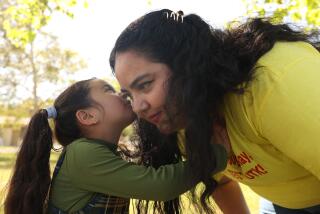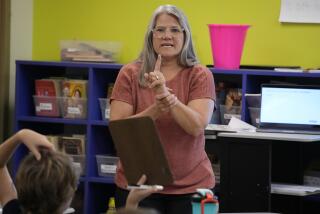Puzzle: There’s No Answer, No Matter How You Slice It
- Share via
Why I have problems with math tests:
The “puzzle” cited in the article, “Strength in Numbers” (Westside, April 7) is misleading to a pragmatist!
I drew this “pizza” four times trying to come up with three cuts and eight equal pieces! I thought of folding it over on itself (a calzone) or stacking the quarters, but immediately discarded the thought because my logic dictates it would be impossible to serve the pieces with all the mozzarella from one slice stuck to the bottom of the next slice! (Inability to think in the abstract?) I hope none of the children tried to demonstrate this “puzzle” to his/her hungry family at dinner time! Any mother has “war stories” to tell about the Solomonic decision of who is going to get the piece of pizza with the pepperoni and cheese stuck to the top of the box!
I now understand why I have so much trouble with the math portions of timed tests! I skip all of them and go back when I’ve finished all the other parts of the test (if I have enough time left) and try to figure them out!
PATRICIA G. RUBIN
Los Angeles
P.S.: My son, the pizza cook, came to the same conclusion that I did. My son, the computer programmer, said to stack them up in quarters and slice in eight equal pieces, never giving a thought to the consequences of this act in regard to all the pieces sticking together!
*
Regarding the article (“Strength in Numbers”), we would like to thank Mathis Chazanov for presenting our viewpoint concerning the tracking or “ability grouping” issue at Horace Mann School. We would, however, like to clarify our central points, which are that ability grouping is not the answer for high test scores and that ability grouping in fourth and fifth grades has a negative impact on self-esteem. We have done much research on the subject, which first caught our interest when our children in fourth grade were placed in low and middle math groups, even though one had tested in the superior range in logic and reasoning and the other received 98% on the math portion of the C.A.T. Test.
To show that ability grouping has a positive effect for everyone, one must show how all three fourth-grade teachers at Horace Mann of all three ability groups teach math. Clearly, the article leaned strongly on discussion of the teaching style of Ellen Morehead, the “high” math teacher since there were no quotes from Rachael Zanka, the “low” math teacher and only one quote from Lynn Koff, the “middle” math teacher. Also it is noteworthy that all of the children quoted in the April 7 article are in the “high” math group.
Also, to prove that ability grouping is successful, one must show how many children move up to a higher group and/or significantly improve their test scores. In the two years that our children were in the fourth and fifth grade, we know of only two students who moved from one group to another. One movement occurred after a child cried when placed in the low group. This child was moved to the middle group. A second instance was when after a parent complained, a child was moved from the middle to the high group. In both instances, it is interesting to note that academic achievement was not the basis for the movement. So, despite what Mr. Sol Levine and the three fourth-grade math teachers stated in the article, the ability groups are not flexible.
The article states that “ability groups make it easier for teachers to pay attention to the children at the top and bottom of their classes, extremes that are often neglected when teaching everybody at once.” However, Jeannie Oakes states in her book, “Keeping Track: How Schools Structure Inequality,” that “the fact that tracking may make teaching easier for some teachers should not cloud our judgment about whether that teaching is best for any group of students--whatever their abilities.”
Since the brain develops at different rates, to lock children into a group at such an early age based on a test they are given when they are 9 years old is unfair and educationally unsound. The ability grouping system works only for those who are selected in a kind of educational Schindler’s List to receive the most stimulating curriculum. The other children have very little chance of moving up for the following reasons:
1. Lowered self-esteem. A social hierarchy quickly develops on the playground, which mirrors the artificially created academic hierarchy in the classroom.
2. A teaching style and different curriculum which is demonstrated by fourth-grade student Micah Amado, who said, “The people that are really strong go to a math class that’s really hot. It’s better ‘cause the math book is really dull.” This indicates what Jeannie Oakes and we ourselves have observed, which is, as Oakes puts it, “high-track classes focused primarily on mathematical concepts; low-track classes stressed basic computational skills and math facts.” As a result low-group students are denied access to knowledge that could enable them to move up to a higher group.
3. Class size. In other words, the high group simply cannot hold all the students in the grade. If there are three math classes with a maximum of 30 students in each class, in order for an individual to move up, someone must move down. One fourth-grade teacher was even overheard explaining to a fourth-grade parent that her child belonged in a higher math group but there wasn’t enough room!
Our children, who now attend two different private schools, are succeeding in math. Their classes offer opportunities to each and every student. No one is excluded based on their “ability level.”
In our opinion, there seem to be some constitutional issues that could be addressed concerning “ability grouping” for, in the words of the educational philosopher Gary Fenster-Macher, “ . . . using individual differences in aptitude, ability or interest as the basis for curricular variation denies students equal access to the knowledge and understanding available to mankind.”
ROSANNA and GARY GRABEL
DEBORAH and ALAN MEHREZ
Beverly Hills


